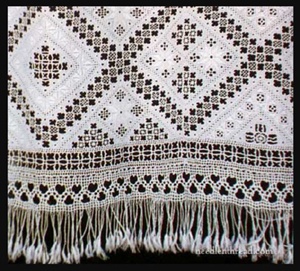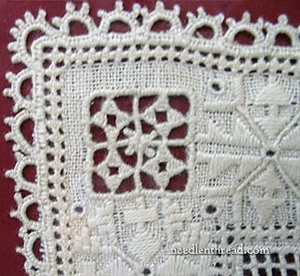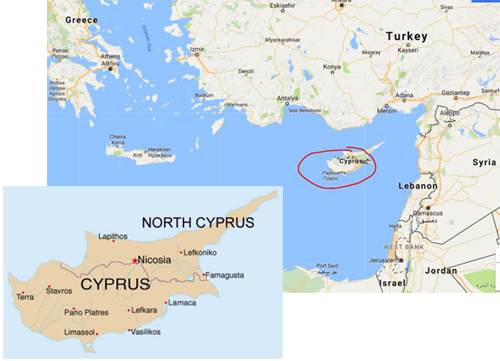What's Out There: Lefkara Lace
 Lefkara Lace (or Lefkaritika) is made on the island of Cyprus in the village of Lefkara and is on the UNESCO cultural heritage list. It is a bit reminiscent of Hardanger (Norwegian whitework), in that it uses a white background, white thread, and cut or drawn threads to form the design. Traditionally, a girl would have an extensive collection of embroidered linens to display at her wedding as part of her dowry. The lace became well-known as the Lefkara men were merchants and traders. The lace designs were traded all around the Mediterranean. In the 15th century, Leonardo Da Vinci is thought to have visited Cyprus and brought Lefkara Lace back to Italy with him, which today decorates Duomo Cathedral in Milan. Cyprus was a significant textile and trading center. They exported lace back to Venice in the 15th and 16th centuries.
Lefkara Lace (or Lefkaritika) is made on the island of Cyprus in the village of Lefkara and is on the UNESCO cultural heritage list. It is a bit reminiscent of Hardanger (Norwegian whitework), in that it uses a white background, white thread, and cut or drawn threads to form the design. Traditionally, a girl would have an extensive collection of embroidered linens to display at her wedding as part of her dowry. The lace became well-known as the Lefkara men were merchants and traders. The lace designs were traded all around the Mediterranean. In the 15th century, Leonardo Da Vinci is thought to have visited Cyprus and brought Lefkara Lace back to Italy with him, which today decorates Duomo Cathedral in Milan. Cyprus was a significant textile and trading center. They exported lace back to Venice in the 15th and 16th centuries.
 The techniques, materials, and the names of the motifs record Cypriot history. In the late 1400s, the Venetians came to Cyprus, and Venetian ladies embroidered. Local women delivering water from springs would see their embroidery. When the Venetians left, some embroideries were left behind. The local women figured out how the designs were made, then modified them to suit themselves and their local style. Mothers would pass on the patterns to their daughters and often each village would make slight changes. The designs consist of geometric shapes that are either raised or cut, creating a complex three-dimensional pattern. To work the embroidery, the ground fabric is pinned to a thin colored pillow, placed on the lap. The colored fabric underneath allows the embroiderer to better see the design. Threads are counted and cut, then the cut edges are worked with thread. The raised elements are named for common household items from the past, such as lanterns, ladders or baskets. These motifs can be combined and recombined for almost endless designs.
The techniques, materials, and the names of the motifs record Cypriot history. In the late 1400s, the Venetians came to Cyprus, and Venetian ladies embroidered. Local women delivering water from springs would see their embroidery. When the Venetians left, some embroideries were left behind. The local women figured out how the designs were made, then modified them to suit themselves and their local style. Mothers would pass on the patterns to their daughters and often each village would make slight changes. The designs consist of geometric shapes that are either raised or cut, creating a complex three-dimensional pattern. To work the embroidery, the ground fabric is pinned to a thin colored pillow, placed on the lap. The colored fabric underneath allows the embroiderer to better see the design. Threads are counted and cut, then the cut edges are worked with thread. The raised elements are named for common household items from the past, such as lanterns, ladders or baskets. These motifs can be combined and recombined for almost endless designs.

Lacemaking provided women with a way to participate in the economy and still does today. In 2009, it was a main industry in the Lefkara area in spite of the economic downturn. A table cloth can take two or more years of work.
Videos of Lacemaking:
Lefkara Laces – Before Memory Fades A good history of Lefkara Lace with nice video footage of the village and people making the lace.
Lacemaking in Lefkara, Cyprus Shots of city streets, the tourist trade and an interview with a shopkeeper who sells the lace in the village. Payment is by the motif, not by the hour.
Lefkara laces or Lefkaritika This video has footage from what looks like the 1930s or 40s, as well as more current interviews. Photos included toward the end from the early 1900s show an amazing 30′ tablecloth that must have cost a kingly sum.
Cyprus 1969 Reel 52 of 65 This video has close-ups of someone embroidering. You can see the pillow and how the stitches are made. An experienced stitcher is very fast!
Lefkara Lace can be purchased online. One source is Lefkara Lace Gifts on Etsy. A ‘table cloth’ is more like what we think of as a table runner or centerpiece. A piece the size of a placemat is about $80 plus shipping. A steal considering how much work these take; however I’d be terrified to put them on the table! There are some beautiful examples of the art in this shop.
Happy Sewing!

